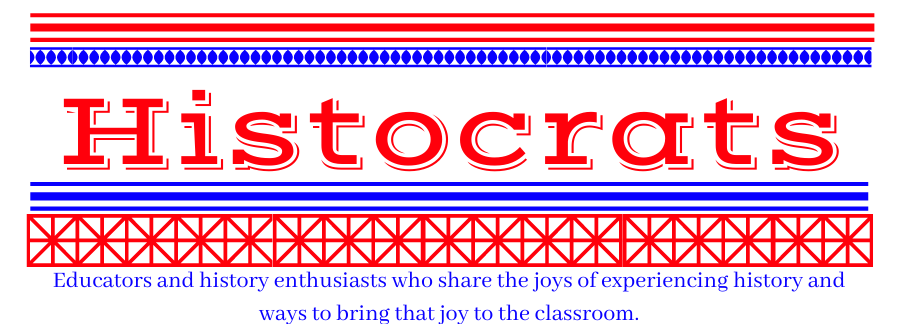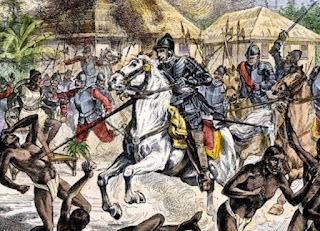Puritans gone wild on a tropical island, as their confused and desperate advisors in 17th century London try to rail them in.
Enslaved people in the Deep South who run their own profitable businesses.
A thirtysomething Midwestern couple, successful but bored, buy an RV, and became nomads in California . . . Starting in 1850.
These are just three of the many subjects I write about at Non-Boring History on Substack. And I also gently suggest why you might care.
Most academic history is about history that matters, but it is written first, foremost, and sometimes only, for scholars. That’s a great shame, because there are so many fantastic stories and interpretations trapped in books and articles written only for the few.
I want to fix that. I am a Brit in the U.S. I am a missionary for history. And I am also an academic historian. Years ago, I bailed from my job as a tenured professor of history and member of the Africana Studies faculty at Georgia Southern University. Fed up with modern university life, I started writing MG/YA time-travel novels, and bringing adapted college lectures to elementary and middle-school audiences. Then I started talking to teachers.
And now, after decades of working with audiences ranging from hungover freshmen to excited kids and teachers, I’m also writing for the adult public.
Non-Boring History is an entertaining introduction to what my readers never knew they never knew about the past (with apologies to Disney’s Pocahontas). It tackles an ever-changing variety of subjects, drawn from the areas I know best, US and British history, with a special interest in Black history. I show how these connect with each other, and with us. This is very much a living past, not a dusty collection of antiques.
As a historian whose academic work dealt less with famous names than with the rest of us, I am keen to spread the word about why that’s incredibly important. Non-Boring History spotlights real people, just like the diverse audience I write for, who are based throughout the US, the UK, and beyond. My subscribers know I’m honest about the limits of my knowledge, and trust me to be their entertaining and intriguing guide through the forests of history. It’s also a personal take, reflecting 40 years of going between two countries.
I bring Non-Boring History readers a variety of subjects, and in a variety of styles:
On The Road posts cover my past and present travels through the US and UK, and invite my readers to come along as armchair travelers, and plan for their own future trips. My husband, other family members, and friends are regular characters, and readers share in the drama and comedy as, in pursuit of the past, I get us lost in deserts, battle Los Angeles traffic, and stumble across fascinating and eccentric museums (and delightful people) throughout Britain. I also offer pointers to avoiding boredom and disappointment at historic sites.
A Bit of History posts are about objects from my junk, um, antique collection. Why does a truly ugly print hang over my desk? Who wrote a postcard I own? I encourage readers to think anew about their own heirlooms and collectibles.
Annette Tells Tales is at the heart of Non-Boring History, and also comes in podcast form. I tell astonishing stories from the past, often drawn from academic history, and I do that in the same non-snotty way I write about everything else. Don’t be deceived by my breezy and often funny style: This is important stuff, not trivia. That’s why I wrote recently about enslaved people in early Georgia and South Carolina who ran their own businesses: As a historian, I have long been concerned to read of folks who find it slightly shameful to be descended from slaves. I want everyone to know that historians have written a lot and in detail about the incredible initiatives that enslaved African-Americans took to disrupt the brutal system of slavery.
Based on the work of Cambridge professor Betty Wood and her former student Dr. Tim Lockley, I wrote about Charles Ball, an enslaved man who managed the plantation fishery where he worked (and also skillfully managed his overseer and his owner), William Grimes, an enslaved man who made his own way in 19th century Georgia’s gig economy, and “Sarah”, a composite character based on actual enslaved women and men who sold their own produce at markets in Savannah and Charleston.
And I bring subjects like these to light in chatty posts you can enjoy with your feet up and a cup of coffee.
I love that Non-Boring History is so much more than a blog. Substack’s format stores every post in an easy-to-read, organized, and searchable site, without ads. It brings together a community of adults from around the world, especially from the US and the UK, to talk about history in friendly, non-shouty ways, in a moderated comments section that is limited to subscribers.
Non-Boring History depends on a unique skillset: My training as a historian and as a journalist, and my work for audiences ranging from ages 9 through adult, which have taught me to write about complicated things in easily-understood and entertaining ways. Indeed, I am delighted that historians are encouraging me to do just that. Professor Lockley, now at the University of Warwick in the UK, on whose work I based my post about enslaved folks in business, wrote, "You did a great job of making a very complex situation believable and clear to a non-academic audience."
“Nonnies”, paying subscribers to Non-Boring History, are members of a special community, and they get exclusive commenting privileges, posts, giveaways, and other opportunities to read and interact. Non-paying readers are warmly welcomed, and they currently enjoy many past posts at Non-Boring History for free. But more and more of my work going behind a paywall, and I won’t apologize for that: We have paid a catastrophic price for demanding that writers write for free on the web, and it’s called clickbait. I don’t do that.
Interested? Go to http://annettelaing.substack.com , and click on “Let Me Look Around First”.
Want to be a Nonnie? Use this link to sign up through September 22, 2021, and you subscribe for just $48 a year, 20% off the standard rate: https://annettelaing.substack.com/histocrats2021
To learn more about me, my books, and my work as in schools and with the public around the US, visit http://AnnetteLaing.com
And, as the saying goes, do tell a friend.



































